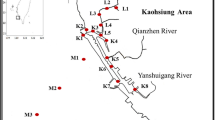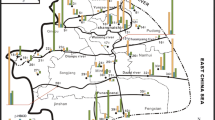Abstract
In this study, hexabromocyclododecane (HBCD) in riverine and estuarine sediments was investigated in Osaka, Japan. The mean total HBCD concentration detected in sediments ranged from < 0.50 to 130 ng g−1 dry weight. This exceeded the ubiquitous HBCD contamination level found globally but was lower than that in areas affected by point sources, such as textile industries and expanded polystyrene plants. Sewage effluent was one of the suspected point sources of HBCD in the study area. The HBCD concentrations in sediments were highly dependent on certain factors, such as the location of the sampling site (proximity to possible emission sources), sediment properties (silt or sand), and organic substance content. The range of the diastereomer composition of α- and γ-HBCD was wider than that in other studies. Repeatability tests (n = 3) were conducted for all samples to assess the variability in the HBCD concentrations within identical sediment samples. Some variations were observed in the HBCD concentrations and diastereomer compositions within the repeatability test results at some sampling sites; nevertheless, the same samples were extracted and analyzed in triplicate. The bromine contents of the extracts of these samples were analyzed by X-ray fluorescence, and the results agreed well with those estimated from the LC-MS/MS results. From these results, it was confirmed that several sediment samples contained heterogeneously distributed HBCD. The risk characterization ratios (predicted environmental concentration/predicted no-effect concentration) of sites with high HBCD concentrations ranged from 0.1 to 1; thus, further information is required, and the sediment HBCD levels in this region should be continuously studied.





Similar content being viewed by others
References
Al-Odaini NA, Shim WJ, Han GM, Jang M, Hong SH (2015) Enrichment of hexabromocyclododecanes in coastal sediments near aquaculture areas and a wastewater treatment plant in a semi-enclosed bay in South Korea. Sci Total Environ 505:290–298. https://doi.org/10.1016/j.scitotenv.2014.10.019
Covaci A, Gerecke AC, Law RJ, Voorspoels S, Kohler M, Heeb NV, Leslie H, Allchin CR, de Boer J (2006) Hexabromocyclododecanes (HBCDs) in the environment and humans: a review. Environ Sci Technol 40:3679–3688. https://doi.org/10.1021/es0602492
Davis JW, Gonsior SJ, Markham DA, Friederich U, Hunziker RW, Ariano JM (2006) Biodegradation and product identification of [14C] hexabromocyclododecane in wastewater sludge and freshwater aquatic sediment. Environ Sci Technol 40:5395–5401. https://doi.org/10.1021/es060009m
Drage D, Mueller JF, Birch G, Eaglesham G, Hearn LK, Harrad S (2015) Historical trends of PBDEs and HBCDs in sediment cores from Sydney estuary. Australia Sci Total Environ 512–513:177–184. https://doi.org/10.1016/j.scitotenv.2015.01.034
ECHA (2016) Guidance on information requirements and chemical safety assessment, chapter R.16: environmental exposure assessment, https://echa.europa.eu/documents/10162/13632/information_requirements_r16_en.pdf, Accessed 28 February 2020
European Commission (2008) Risk assessment hexabromocyclododecane, https://echa.europa.eu/documents/10162/661bff17-dc0a-4475-9758-40bdd6198f82, Accessed 28 February 2020
Feng AH, Chen SJ, Chen MY, He MJ, Luo XJ, Mai BX (2012) Hexabromocyclododecane (HBCD) and tetrabromobisphenol A (TBBPA) in riverine and estuarine sediments of the Pearl River Delta in southern China, with emphasis on spatial variability in diastereoisomer- and enantiomer-specific distribution of HBCD. Mar Pollut Bull 64:919–925. https://doi.org/10.1016/j.marpolbul.2012.03.008
Gerecke AC, Giger W, Hartmann PC, Heeb NV, Kohler HP, Schmid P, Zennegg M, Kohler M (2006) Anaerobic degradation of brominated flame retardants in sewage sludge. Chemosphere 64:311–317. https://doi.org/10.1016/j.chemosphere.2005.12.016
Guerra P, Cal ADL, Marsh G, Eljarrat E, Barceló D (2009) Transfer of hexabromocyclododecane from industrial effluents to sediments and biota: case study in Cinca river (Spain). J Hydrol 369:360–367. https://doi.org/10.1016/j.jhydrol.2009.02.024
Guerra P, Eljarrat E, Barceló D (2010) Simultaneous determination of hexabromocyclododecane, tetrabromobisphenol A, and related compounds in sewage sludge and sediment samples from Ebro River basin (Spain). Anal Bioanal Chem 397:2817–2824. https://doi.org/10.1007/s00216-010-3670-3
Haga Y, Yoshiki R, Nakagoshi A, Fujimori K, Matsumura C (2016) Distribution of hexabromocyclododecane (HBCD) in river sediment in Hyogo. 25th symposium on environmental chemistry abstracts, 399–400 (in Japanese)
Harrad S, Abdallah MA, Covaci A (2009a) Causes of variability in concentrations and diastereomer patterns of hexabromocyclododecanes in indoor dust. Environ Int 35:573–579. https://doi.org/10.1016/j.envint.2008.10.005
Harrad S, Abdallah MA, Rose NL, Turner SD, Davidson TA (2009b) Current-use brominated flame retardants in water, sediment, and fish from English lakes. Environ Sci Technol 43:9077–9083. https://doi.org/10.1021/es902185u
Heeb NV, Schweizer WB, Mattrel P, Haag R, Gerecke AC, Schmid P, Zennegg M, Vonmont H (2008) Regio- and stereoselective isomerization of hexabromocyclododecanes (HBCDs): kinetics and mechanism of γ- to α-HBCD isomerization. Chemosphere 73:1201–1210. https://doi.org/10.1016/j.chemosphere.2008.07.045
ICAP (International Conference of Aquapolises), 1995. News Letter "AQUAPOLIS" No. 1, https://www.city.osaka.lg.jp/contents/wdu020/kensetsu/english/icap/en/aquapolis/img/aquapolis_no_1.pdf, Accessed 28 February 2020
Ichihara M, Yamamoto A, Takakura K, Kakutani N, Sudo M (2014) Distribution and pollutant load of hexabromocyclododecane (HBCD) in water and sewage treatment plant from Japanese River. Chemosphere 110:78–84. https://doi.org/10.1016/j.chemosphere.2014.03.074
Ichihara M, Yamamoto A, Kakutani N, Takakura K, Sudo M (2019) Inhomogeneity of sediment samples in analysis of hexabromocyclododecane. Environ Monit Assess 191:410. https://doi.org/10.1007/s10661-019-7553-6
Ilyas M, Sudaryanto A, Setiawan IE, Riyadi AS, Isobe T, Takahashi S, Tanabe S (2011) Characterization of polychlorinated biphenyls and brominated flame retardants in sediments from riverine and coastal waters of Surabaya, Indonesia. Mar Pollut Bull 62:89–98. https://doi.org/10.1016/j.marpolbul.2010.09.006
Iqbal M, Syed JH, Katsoyiannis A, Malik RN, Farooqi A, Butt A, Li J, Zhang G, Cincinelli A, Jones KC (2017) Legacy and emerging flame retardants (FRs) in the freshwater ecosystem: a review. Environ Res 152:26–42. https://doi.org/10.1016/j.envres.2016.09.024
Kishida M (2013) Distribution characteristics and source identification of polychlorinated dibenzo-p-dioxin and dibenzofurans, and dioxin-like polychlorinated biphenyls in the waters from river Kanzaki, running through Osaka urban area, Japan. J Environ Sci 25:441–451. https://doi.org/10.1016/S1001-0742(12)60091-6
Klosterhaus SL, Stapleton HM, La Guardia MJ, Greig DJ (2012) Brominated and chlorinated flame retardants in San Francisco Bay sediments and wildlife. Environ Int 47:56–65. https://doi.org/10.1016/j.envint.2012.06.005
Kohler M, Zennegg M, Bogdal C, Gerecke AC, Schmid P, Heeb NV, Sturm M, Vonmont H, Kohler HP, Giger W (2008) Temporal trends, congener patterns, and sources of octa-, nona-, and decabromodiphenyl ethers (PBDE) and hexabromocyclododecanes (HBCD) in Swiss lake sediments. Environ Sci Technol 42:6378–6384. https://doi.org/10.1021/es702586r
Köppen R, Becker R, Jung C, Nehls I (2008) On the thermally induced isomerisation of hexabromocyclododecane stereoisomers. Chemosphere 71:656–662. https://doi.org/10.1016/j.chemosphere.2007.11.009
Law RJ, Covaci A, Harrad S, Herzke D, Abdallah MA, Fernie K, Toms LM, Takigami H (2014) Levels and trends of PBDEs and HBCDs in the global environment: status at the end of 2012. Environ Int 65:147–158. https://doi.org/10.1016/j.envint.2014.01.006
Managaki S, Enomoto I, Masunaga S (2012) Sources and distribution of hexabromocyclododecanes (HBCDs) in Japanese river sediment. J Environ Monit 14:901–907. https://doi.org/10.1039/C2EM10621C
Marvin CH, Tomy GT, Alaee M, Macinnis G (2006) Distribution of hexabromocyclododecane in Detroit River suspended sediments. Chemosphere 64:268–275. https://doi.org/10.1016/j.chemosphere.2005.12.011
Marvin CH, Tomy GT, Armitage JM, Arnot JA, McCarty L, Covaci A, Palace V (2011) Hexabromocyclododecane: current understanding of chemistry, environmental fate and toxicology and implications for global management. Environ Sci Technol 45:8613–8623. https://doi.org/10.1021/es201548c
Minh NH, Isobe T, Ueno D, Matsumoto K, Mine M, Kajiwara N, Takahashi S, Tanabe S (2007) Spatial distribution and vertical profile of polybrominated diphenyl ethers and hexabromocyclododecanes in sediment core from Tokyo Bay, Japan. Environ Pollut 148:409–417. https://doi.org/10.1016/j.envpol.2006.12.011
Ministry of the Environment (MOE), Japan (2011) Guidelines of the initial risk assessment of chemical in the environment (in Japanese), http://www.env.go.jp/chemi/report/h26-01/pdf/chpt1/1-2-1.pdf, Accessed 28 February 2020
Ministry of the Environment (MOE), Japan (2012) Sediment monitoring methods (in Japanese), http://www.env.go.jp/water/teishitsu-chousa/00_full.pdf, Accessed 28 February 2020
Morris S, Allchin CR, Zegers BN, Haftka JJH, Boon JP, Belpaire C, Leonards PEG, van Leeuwen SPJ, de Boer J (2004) Distribution and fate of HBCD and TBBPA brominated flame retardants in North Sea estuaries and aquatic food webs. Environ Sci Technol 38:5497–5504. https://doi.org/10.1021/es049640i
Oh JK, Kotani K, Managaki S, Masunaga S (2014) Levels and distribution of hexabromocyclododecane and its lower brominated derivative in Japanese riverine environment. Chemosphere 109:157–163. https://doi.org/10.1016/j.chemosphere.2014.01.074
Poma G, Roscioli C, Guzzella L (2014) PBDE, HBCD, and novel brominated flame retardant contamination in sediments from Lake Maggiore (northern Italy). Environ Monit Assess 186:7683–7692. https://doi.org/10.1007/s10661-014-3959-3
R Core Team (2020) R: a language and environment for statistical computing. R Foundation for Statistical Computing, Vienna. https://www.R-project.org/
Ramu K, Isobe T, Takahashi S, Kim EY, Min BY, We SU, Tanabe S (2010) Spatial distribution of polybrominated diphenyl ethers and hexabromocyclododecanes in sediments from coastal waters of Korea. Chemosphere 79:713–719. https://doi.org/10.1016/j.chemosphere.2010.02.048
Remberger M, Sternbeck J, Palm A, Kaj L, Strömberg K, Lundén EB (2004) The environmental occurrence of hexabromocyclododecane in Sweden. Chemosphere 54:9–21. https://doi.org/10.1016/S0045-6535(03)00758-6
Sakiyama T, Kakutani N, Yamamoto A, Yamamoto K, Mori Y, Fukuyama J (2005) Occurrence of dioxins in water and sediment from Osaka City. Ann Report Osaka City Inst Public Health Environ Sci 67:37–46 (in Japanese)
Ueno D, Alaee M, Marvin C, Muir DC, Macinnis G, Reiner E, Crozier P, Furdui VI, Subramanian A, Fillmann G, Lam PK, Zheng GJ, Muchtar M, Razak H, Prudente M, Chung KH, Tanabe S (2006) Distribution and transportability of hexabromocyclododecane (HBCD) in the Asia-Pacific region using skipjack tuna as a bioindicator. Environ Pollut 144:238–247. https://doi.org/10.1016/j.envpol.2005.12.024
Ueno D, Isobe T, Ramu K, Tanabe S, Alaee M, Marvin C, Inoue K, Someya T, Miyajima T, Kodama H, Nakata H (2010) Spatial distribution of hexabromocyclododecanes (HBCDs), polybrominated diphenyl ethers (PBDEs) and organochlorines in bivalves from Japanese coastal waters. Chemosphere 78:1213–1219. https://doi.org/10.1016/j.chemosphere.2009.12.058
UNEP Stockholm Convention (2015) Guidance for the inventory, identification and substitution of Hexabromocyclododecane (HBCD), http://chm.pops.int/Portals/0/download.aspx?d=UNEP-POPS-NIP-GUID-InventoryAndSubstitution-HBCD-201703.En.pdf, Accessed 28 February 2020
Wit CAD (2002) An overview of brominated flame retardants in the environment. Chemosphere 46:583–624. https://doi.org/10.1016/S0045-6535(01)00225-9
Yamamoto A, Terao T, Hisatomi H, Kawasaki H, Arakawa R (2012) Evaluation of river pollution of neonicotinoids in Osaka City (Japan) by LC/MS with dopant-assisted photoionisation. J Environ Monit 14:2189–2194. https://doi.org/10.1039/c2em30296a
Yang R, Wei H, Guo J, Li A (2012) Emerging brominated flame retardants in the sediment of the Great Lakes. Environ Sci Technol 46:3119–3126. https://doi.org/10.1021/es204141p
Zhang Y, Ruan Y, Sun H, Zhao L, Gan Z (2013) Hexabromocyclododecanes in surface sediments and a sediment core from Rivers and Harbor in the northern Chinese city of Tianjin. Chemosphere 90:1610–1616. https://doi.org/10.1016/j.chemosphere.2012.08.037
Acknowledgments
We thank Osaka City Environment Bureau, Japan, for kindly providing the studied sediment samples. We would like to thank Editage (www.editage.com) for providing help with English language editing.
Author information
Authors and Affiliations
Corresponding author
Ethics declarations
Conflict of interest
The authors declare that they have no conflict of interest.
Additional information
Responsible editor: Ester Heath
Publisher’s note
Springer Nature remains neutral with regard to jurisdictional claims in published maps and institutional affiliations.
Electronic supplementary material
ESM 1
(PDF 673 kb)
Rights and permissions
About this article
Cite this article
Ichihara, M., Yamamoto, A., Kakutani, N. et al. Hexabromocyclododecane in riverine and estuarine sediments from Osaka, Japan: spatial distribution and concentration variability within identical samples. Environ Sci Pollut Res 27, 35782–35791 (2020). https://doi.org/10.1007/s11356-020-09856-0
Received:
Accepted:
Published:
Issue Date:
DOI: https://doi.org/10.1007/s11356-020-09856-0




